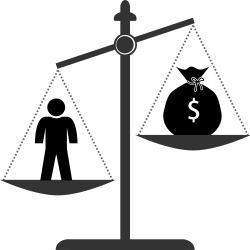“The opioid epidemic” has triggered an extreme governmental reaction. While blaming legitimate manufacturers, curbing pain meds is the government’s go-to approach -- to the horror of those who legitimately need pain relief. Could the government have curtailed the problem from the get-go, and were they just asleep at the helm? Could present measures be a diversionary tactic?
As usual, the answer is nuanced. Thousands of legitimate patients needing pain or anxiety relief find it nearly impossible to get their meds. That’s one tragedy. Over one hundred thousand deaths were reported during the last calendar year from drug overdoses. That’s another. Most people agree that the illicit manufacture of synthetic opioids drives the current epidemic, and restricting legitimate pain medication won’t address this concern. And we have the blame game: blame the manufacturers, the street, or the government’s overreaction. But there are other unrecognized and impactful forces in this drama.
The Blame Game
Initially, Purdue Pharma and its confreres were saddled with much blame – for overmarketing, overhyping, under-warning, and over-motivating doctors to prescribe unneeded drugs, using questionable tactics. Their product was designated for the legitimate pain patient; sadly, in some cases facilitating addiction. But by 2008, Purdue’s product no longer became the “drug of choice.” Instead, a generic form, minus the time-release coating Purdue marketed to prevent addiction, took center stage. “Blues”, a powder blue pill embossed with an “M”m for its manufacturer, Mallinckrodt, contained 30 mg of oxycodone, roughly the equivalent of a hit of heroin. One popped “blue” brought an instant rush of pure oxycodone. And so began the “blue highway.” If ever a product was defective and unreasonably dangerous, surely this could qualify. In 2008, Mallinckrodt made ten times more pills than Purdue, and massive amounts found their way to those who comprised a majority of opioid casualties.
Between the source (pharma) and the end-user are intermediaries, distributors, pharmacies, and physicians. Doctors who write the prescriptions, presumably using their own judgment, retained some skepticism as the drug company’s detailers dumped the cute dangly on their desks to induce prescribing Then there are the pharmacies who fill the prescriptions, getting their supplies from distributors. These distributors, in many cases, over-supplied the pharmacies, leading to street consumption and creating the need that was eventually filled by the illicit synthetics.
For example, in 2008, in Kermit, West Virginia, bordering on Kentucky, with a population of 300, "Miami-Luken [a distributor] alone, provided 5,624 pills for every man, woman, and child in Kermit."
The federal government is charged with regulating the distributors. But somewhere, something went wrong. Governmental neglect transcended both Presidents Obama's and Trump's administrations. From the beginning, some government lawyers seemed asleep at the helm; their tepid responses allowed distributors to flood the market, filling astronomical and irrational orders. These were for legitimate drugs - but often for illegitimate consumers, at least according to the recent book American Cartel: Inside the Battle to Bring Down the Opioid Industry.
Big orders mean massive consumption, massive consumption often means addiction, and addiction attracts black-market substitutes, like fentanyl and its cousins, to fill the ensuing need. The “big three distributors”, Amerisource Bergen Corp, Cardinal Health, and the McKesson Corporation, transported nearly 95% of all pharmaceuticals in the US from manufacturers to “individual pharmacies,” including mass retailers like CVS and Walmart that buy in bulk (and which deny culpability).
Drug surveillance falls to the Drug Enforcement Administration, the DEA. Federal laws are in place to surveil unusually large, frequent, or suspicious orders either in number or pattern, requiring reporting such transactions to the DEA. Enforcement of these laws, once discovered broken by the DEA, lies with the Justice Department.
“[To prevent controlled substances from being diverted for illegal uses, the CSA [Controlled Substance Act] requires wholesalers that distribute controlled substances to pharmacies and other customers to monitor their customers’ controlled-substance orders. …
This legal obligation requires distributors either to look into their customers’ orders if there is suspicious activity and resolve the suspicion or to alert DEA to their customers’ suspicious behavior.”
The distributors allegedly disregarded the laws, even disregarding their internal monitoring systems. Outrageously large orders were placed over the internet, inviting misuse and diversion to the street and the black market. For example, between October 10 and October 21, 2005, the McKesson Corporation distributed more than two million doses of hydrocodone to six Tampa pharmacies, which sold the pills “over the internet to just about anyone with a credit card. [1]
In 2008, Congress shuttered online pharmacies, passing the Ryan Haight Online Pharmacy Consumer Protection Act, named after an eighteen-year-old teenager who overdosed on the Vicodin he ordered online without ever seeing a doctor or obtaining a prescription. But as one conduit dried up, another opened: “pill mills,” often under the guise of pain clinics, sprouted like wild mushrooms (not even the magic kind) which the distributors supplied with abandon – one street in Broward County boasted 31 pain clinics. Billboards blasted: “Walk-Ins Welcome.” Florida, lacking a prescription drug monitoring program, became the venue of choice for distribution drop-off.
“Drug users and dealers hopped from one location to the next, shopping for doctors who would sell them painkillers in exchange for a few hundred bucks. On the street, each 30-count bottle of oxycodone 30 mg pills went for $900, which the buyer could fill multiple times.”
- American Cartel
Repeated warnings by the DEA had no effect. Indeed, the companies sought to weaken the law legislatively. Hiring lawyers who once worked at the DEA or Justice Department and now championed the private sector and recruiting high-priced lobbyists, the companies succeeded in enlisting “legislative angels,” eventually pressuring the DEA to force out their top investigators and change the law.
Perhaps the most offensive marketing strategy was employed by Amerisource, whose files contained a widely circulated take-off on the Beverly Hillbillies’ song- entitled the “Pillbillies” - parodying the targeted Appalachian consumer.
“Indeed [claims the government], in the midst of the opioid epidemic, AmerisourceBergen Corporation intentionally altered the order monitoring system for its largest subsidiary… in a way that dramatically reduced the number of controlled-substance orders reviewed by employees.”
– American Cartel
As attention to deficient and suspicious distribution and legal enforcement by the Attorney General’s office went wanting, in stepped plaintiffs’ lawyers – the “private attorneys-general.” Claims against distributors and manufacturers were raised nationwide, mainly from the county and state governments saddled with treating the addicted. The plaintiffs invoked an unusual theory – public nuisance: i.e., that the actions by the distributors harmed the public, affecting their health and safety. As I have written, some cases using this theory were lost when courts found that the causal connection between mass prescriptions and the wave of overdoses wasn’t proven.
So, where was the government?
American Cartel, published in July, is a splendidly researched book, with oodles of precise facts fingering lax and collusive government practices along with tagging abusive practices of the distributors. Some five and a half months later, the US government filed an 80-page complaint against AmerisourceBergen and various subsidiaries seeking an unspecified sum in fines and injunctive relief.
“[d]efendants have for years flouted their legal obligations and prioritized profits over the well-being of Americans. The United States brings this suit to hold Defendants accountable for their egregious failure to report suspicious orders and their role in contributing to the opioid epidemic.”
The government’s complaint largely tracks American Cartel’s narrative without the painstaking detail and specificity the book provides, nor raising other specifics that have since come to light. Two causes of action are raised: breach of statute and negligence.
Is this a case of too little, too late? Will the government succeed in recouping $109,374 for each violation (the number of which is unspecified)?
The distributors have retained the best counsel in the country. While allegations of a statutory breach are easier to prove than nuisance claims, establishing the negligence claim is not. The causal connection between massive over-prescription and the wave of overdoses must still be proven, something that might be difficult and has failed before.
The complaint, which raises nebulous and vague claims that “huge” amounts of drugs were ordered and not reported and “numerous” sales and drug deals”, lacks specificity, that though not required at this stage in the proceedings, might have made their case that much more compelling. [2].
Given the December 29 filing date, I wonder if this a rush to file was government lawyers trying to make up for lost time? What took so long to bring such an action? Had they done so earlier, could the overreaction, locking up the national medicine chest, been avoided?
[1] American Cartel by Scott Higham and Sari Horwitz
[2] For example, “Defendants sell huge quantities of controlled substances, and controlled substances are a significant source of revenue for Defendants…”

